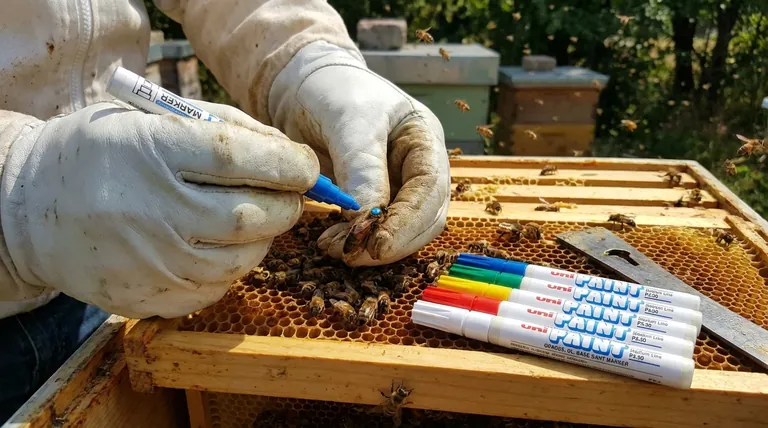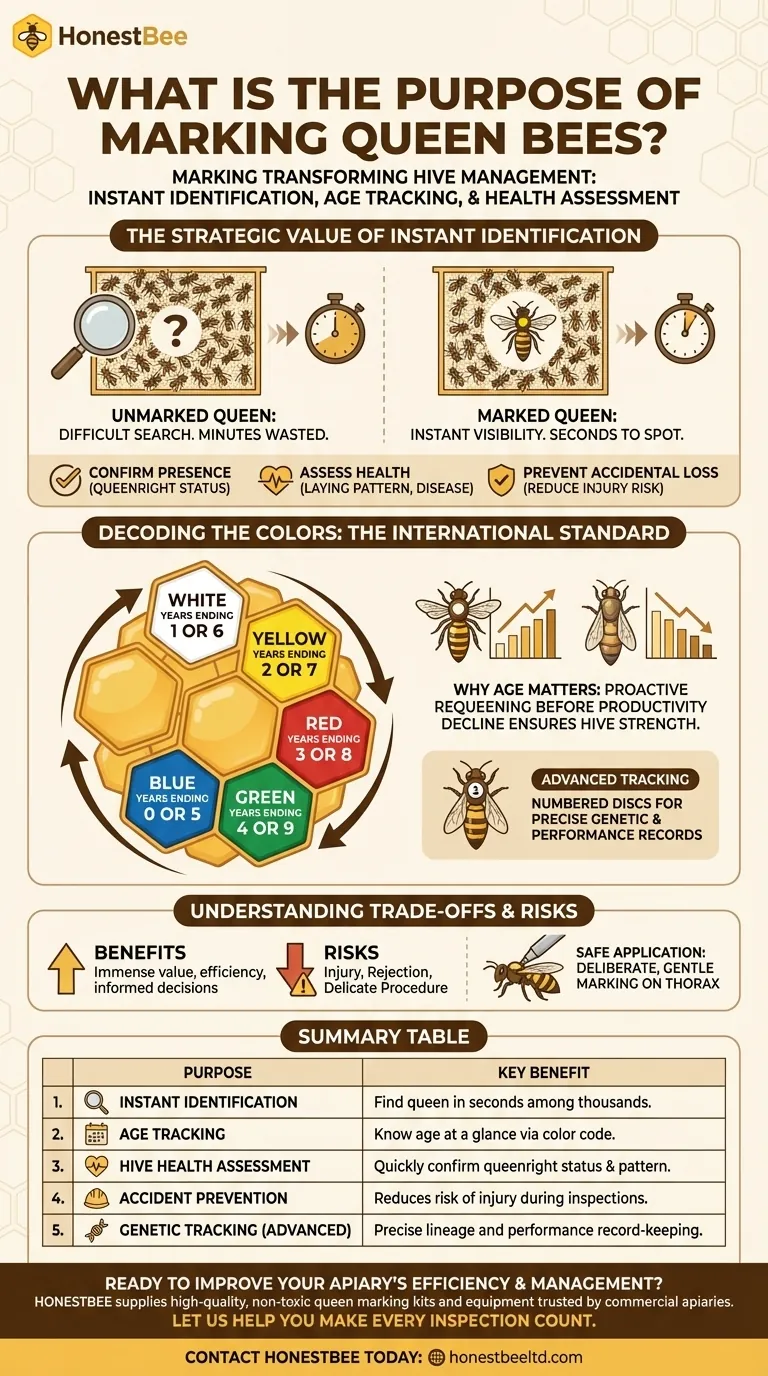The primary purpose of marking a queen bee is to make her instantly identifiable within a colony of tens of thousands of other bees. This simple act of applying a colored dot allows a beekeeper to confirm her presence, assess her health, and determine her age at a glance, transforming a difficult search into an efficient evaluation crucial for hive management.
Finding one specific bee among 50,000 is a monumental task. Marking the queen with a specific color turns her into a clear, high-visibility signal, providing immediate data on the hive's age, lineage, and overall stability.

The Strategic Value of Instant Identification
Marking a queen isn't just about making her easy to find; it's about the management decisions that this speed and certainty enable. It shifts the focus of an inspection from searching to assessing.
From Searching to Assessing
An unmarked queen can take many minutes to locate on a frame crowded with her offspring. A marked queen can often be spotted in seconds.
This saved time is critical, as it allows the beekeeper to focus on more important tasks, such as evaluating the queen's laying pattern, checking for signs of disease, and assessing the hive's food stores.
Confirming the Queen's Presence
The most vital piece of information during an inspection is whether the hive is "queenright." A quick scan for a marked queen provides an immediate answer.
If she is not seen, it is an instant red flag. The beekeeper knows to look for evidence that she has been replaced (supersedure), has left with a swarm, or that the colony has become queenless, which requires urgent intervention.
Preventing Accidental Loss
During hive inspections, frames are moved, bees are brushed aside, and there is always a risk of accidentally "rolling" or crushing the queen. A brightly marked queen is far less likely to be overlooked, significantly reducing the risk of accidental injury or death.
Decoding the Colors: The International Standard
The colors used for marking are not random. Beekeepers use a standardized, five-year international color code that corresponds to the last digit of the year the queen was born or mated.
The Five-Year Color Cycle
This system allows any beekeeper to know a queen's age just by seeing her color. The rotation is as follows:
- Years ending in 1 or 6: White
- Years ending in 2 or 7: Yellow
- Years ending in 3 or 8: Red
- Years ending in 4 or 9: Green
- Years ending in 0 or 5: Blue
Why Age Matters
A queen bee's egg-laying productivity is highest in her first two to three years. After that, her output typically declines.
Knowing her age allows a beekeeper to anticipate this decline. They can proactively requeen the hive with a young, vigorous queen before the colony's population dwindles, ensuring continued strength and honey production.
Advanced Tracking with Numbered Discs
For queen breeders or beekeepers focused on tracking specific genetic lines, an alternative to paint is the use of small, numbered discs.
These discs provide the same age identification via color but add a unique number for that specific queen. This allows for precise record-keeping on the performance and lineage of very valuable queens.
Understanding the Trade-offs and Risks
While immensely beneficial, the act of marking a queen is a delicate procedure that is not without risk. The goal is to apply the mark safely without harming this single most important bee.
The Risk of Injury
The queen must be held gently but firmly to apply the mark. An inexperienced hand can easily damage a leg or antenna, or worse, crush her abdomen. This requires a steady hand and a calm demeanor.
Potential for Rejection
Although uncommon, there is a slight risk that the colony may reject a queen after she is handled and returned. The foreign scent of the paint or the handler can sometimes cause the worker bees to perceive her as an intruder.
Choosing the Right Tool
Beekeepers typically use special-purpose paint pens with non-toxic, quick-drying paint. The process involves carefully isolating the queen, holding her, and applying a small dot of paint to her thorax (the middle section of her body), avoiding her head, wings, and abdomen.
Making the Right Choice for Your Apiary
Applying this knowledge depends on your specific goals as a beekeeper. Marking is a tool, and its application should be deliberate.
- If your primary focus is efficient hobbyist beekeeping: Marking your queen with the correct annual color is the single most valuable practice for enabling quick, low-stress hive assessments.
- If your primary focus is tracking genetics and breeding: Using numbered discs provides the granular, individual data necessary to monitor the performance of specific high-value queens across seasons.
- If your primary focus is minimizing risk as a new beekeeper: Purchase a pre-marked queen or have an experienced mentor mark her for you to avoid the potential for injury while you are learning.
Ultimately, marking a queen transforms her from an anonymous ruler into a known asset, empowering you to make proactive and informed decisions for the long-term health of your hive.
Summary Table:
| Purpose | Key Benefit |
|---|---|
| Instant Identification | Find the queen in seconds, not minutes, among thousands of bees. |
| Age Tracking | Use the international color code to know the queen's age at a glance. |
| Hive Health Assessment | Quickly confirm if the hive is queenright and assess her laying pattern. |
| Accident Prevention | Reduces the risk of accidentally injuring or crushing the queen during inspections. |
| Genetic Tracking (Advanced) | Numbered discs allow for precise lineage and performance record-keeping. |
Ready to improve your apiary's efficiency and management?
Marking your queens is a fundamental skill for any serious beekeeper. HONESTBEE supplies the high-quality, non-toxic queen marking kits and equipment trusted by commercial apiaries and distributors. Our wholesale-focused operations ensure you get the reliable tools you need for precise, low-stress hive assessments.
Let us help you make every inspection count. Contact HONESTBEE today to discuss your beekeeping supply needs!
Visual Guide

Related Products
- Queen Bee Marking Pen UNI Medium Point for Queen and Bee Marking
- Queen Bee Marking Pen POSCA Queen Marking Pens for Beekeeping Bee Markers
- Plastic Queen Marking Tube Cage with Plunger for Beekeeping
- Professional Engraved Round Hive Number Tags for Beekeeping
- HONESTBEE Advanced Ergonomic Stainless Steel Hive Tool for Beekeeping
People Also Ask
- How should a Posca pen be prepared for queen marking? Ensure a Safe, Precise Mark Every Time
- What is the process for priming a paint pen before marking a Queen bee? Ensure a Safe, Quick Marking Procedure
- Why is marking a Queen bee important for beekeepers? Elevate Your Apiary Management
- What are the advantages of using Uni-Posca markers for Queen marking? A Safe, Precise, and Efficient Solution
- What type of markers are commonly used for marking Queen bees? Choose the Safe, Non-Toxic Standard



















